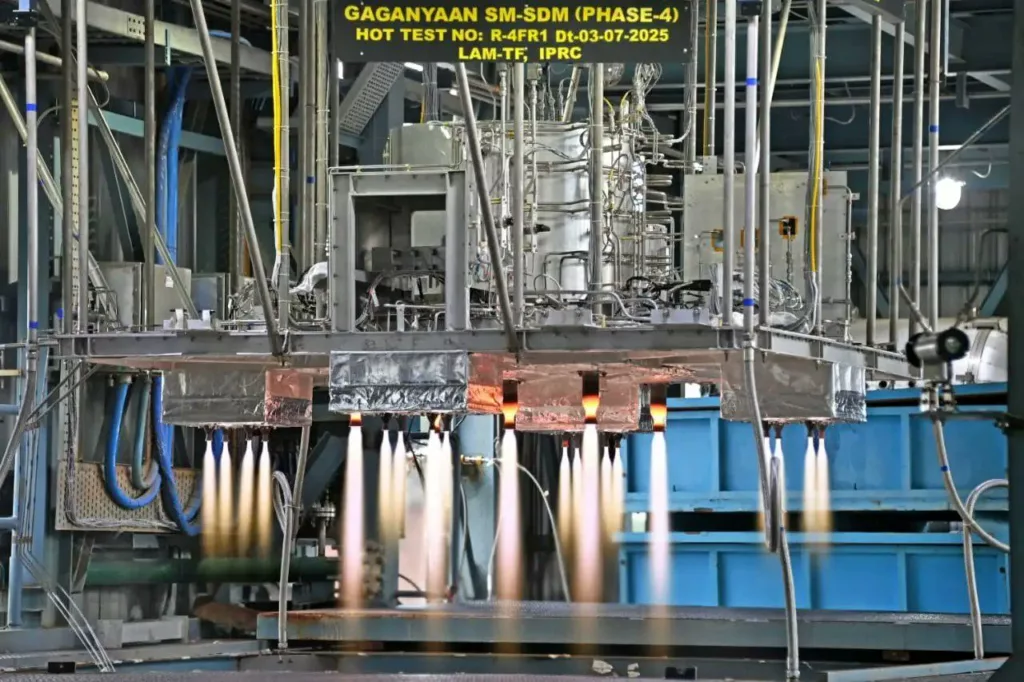ISRO on Saturday, July 12, said it has successfully completed the development of Service Module Propulsion System (SMPS) for Gaganyaan Mission with the completion of the qualification test programme. This came just days before ISRO completed two years of Chandrayaan 3.

A full duration hot test of SMPS for 350 seconds was conducted to validate the integrated performance of the SMPS for flight off-nominal mission profile of the Service Module based mission abort on Friday.
Gaganyaan mission is India’s first human spaceflight mission in the making.
“The overall performance of the propulsion system during the hot test was normal as per pre-test predictions,” ISRO said in a statement.
According to the space agency, “The Service Module (SM) of Gaganyaan is a regulated bi-propellant based propulsion system that caters to the requirements of the Orbital Module for orbit circularisation, on-orbit control, de-boost manoeuvring and Service Module based abort during the ascent phase.”
The Liquid Apogee Motor (LAM) engines provide the main propulsive force during the orbit circularisation and de-boost phases, while the Reaction Control System (RCS) thrusters ensures precise attitude control, it added.
“A System Demonstration Model (SDM) test bed was realised emulating the fluid circuit of the SMPS, encompassing the propellant tank feed system, helium pressurisation system, flight-qualified thrusters, and control components,” ISRO said.
It added that the SDM for SMPS has undergone 25 tests under nominal and off-nominal conditions for a cumulative duration of 14,331s for various Gaganyaan mission scenarios and human rating requirements.
The space agency said the Gaganyaan Service Module Propulsion System is designed, developed, and realised by Liquid Propulsion Systems Centre (LPSC) and the tests were carried out at ISRO Propulsion Complex (IPRC), Mahendragiri in Tamil Nadu.
Chandrayaan 3 Mission
Launched on July 14, 2023, at 2:35 PM (local time) from the Satish Dhawan Space Centre in Sriharikota, India, Chandrayaan-3 was a follow-on mission to Chandrayaan-2.
The main objective of the mission was to successfully deploy a lander and rover in the highland region near the Moon’s south pole, and to demonstrate complete capabilities for landing and surface exploration.
#Throwback July 2023: Etched in history….
— Dr Jitendra Singh (@DrJitendraSingh) July 1, 2025
Exactly two years back, in the same month, every Indian and the world had zoomed in to #Sriharikota….
The launch of #Chandrayaan3 for mankind’s maiden journey to “South Pole” of the Moon, not only established the supremacy of… pic.twitter.com/PG20pUwvKy
On 23rd August 2023, Chandrayaan-3 achieved a historic milestone by successfully performing a soft landing near the Moon’s south pole. With this achievement, India became the fourth country to land on the lunar surface and the first to do so in the challenging terrain of the south polar region.
During the mission, several important scientific experiments were carried out, including measurements of near-surface plasma density, detection of mineral elements, and analysis of the temperature profile of the lunar topsoil.
(With inputs from the Press Trust of India)


